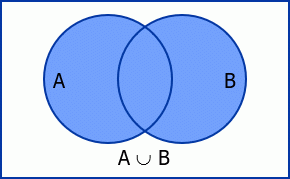There are certain basic operations that can be performed on Sets. Similar to Addition, Subtraction, Multiplication Operations which we come across in Maths we have Union, Intersection, Difference in Set Theory. These operations are performed on two or more sets to result in a New Set depending on the Operation Performed. In the case of Union of Sets, all the elements are included in the result whereas in Intersection only common elements between the Sets are included.
At times you might get confused between Union of Sets and Universal Set. There is a slight difference between Union and Universal Set. Union of two or more sets is an Operation performed on them and includes the elements that are in both sets. On the other hand, Universal Set itself is a Set and has all the elements of other sets along with its set.
Union of Sets Definition
Union of Two Sets A and B is the set of elements that are present in Set A, Set B, or in both Sets A and B. The Union of Sets Operation can be denoted as such
A ∪ B = {a: a ∈ A or a ∈ B}
For instance Let A = { 3, 4, 5} B = { 4, 5, 6, 7} then A U B = { 3, 4, 5, 6, 7}
Go through the further sections to know How to represent the Union of Sets using Venn Diagrams.
Union of Sets Venn Diagram
Let us dive deep into the article to know about the representation of Union of Sets using the Venn Diagram. You can visualize the Operation of Sets with the Diagrammatic Representation.

Consider a Universal Set U in which you have the Subsets A and B. Union of Two Sets A and B is nothing but the elements in Set A and B or both the elements in A and B together. The Union of Sets is denoted by the symbol U.
A U B is the Union of Sets A and B. It is read as A Union B or Union of A and B. The Notation representing the Union of Sets A and B is given as follows
A U B = {x : x ∈ A or x ∈ B}.
It is evident that, x ∈ A U B
⇒ x ∈ A or x ∈ B
In the same way, if x ∉ A U B
⇒ x ∉ A or x ∉ B
Thus, from the definition of Union of Sets, we can say that A ⊆ A U B, B ⊆ A U B.
From the above Venn diagram, we can infer certain theorems
(i) A ∪ A = A (Idempotent theorem)
(ii) If A ⊆ B, then A ⋃ B = B
(iii) A ⋃ U = U (Theorem of ⋃) U is the universal set.
(iv) A ⋃ A’ = U (Theorem of ⋃) U is the universal set.
(v) A ∪ ϕ = A (Theorem of identity element, is the identity of ∪)
(vi) A ∪ B = B ∪ A (Commutative theorem)
Union of Sets Venn Diagram Examples with Solutions
1. If A = { 2, 5, 9, 15, 19} B = { 8, 9, 10, 13, 15, 17}. Find A U B using Venn Diagram?
Solution:
Given Sets are A = { 2, 5, 9, 15, 19} B = { 8, 9, 10, 13, 15, 17}
Let us draw Venn Diagram for the given questions considering the given sets.

A U B is clearly {2, 5, 8, 9, 10, 13, 15, 17, 19} all the elements in both the Sets.
A U B = {2, 5, 8, 9, 10, 13, 15, 17, 19}
2. If P = { 3, 6, 9, 12, 15, 18} Q = { 2, 4, 6, 8, 10, 12, 14, 16, 18}, Find P U Q and the represent the same using Venn Diagram?
Solution:
Given Sets are P = { 3, 6, 9, 12, 15, 18} Q = { 2, 4, 6, 8, 10, 12, 14, 16, 18}
On Drawing the Venn Diagram for the given sets we have the P U Q as under

It is clearly evident from the Venn Diagram that P U Q = {2, 3, 4, 6, 8, 9, 10, 12, 14, 15, 16, 18}
Thus, P U Q = {2, 3, 4, 6, 8, 9, 10, 12, 14, 15, 16, 18}